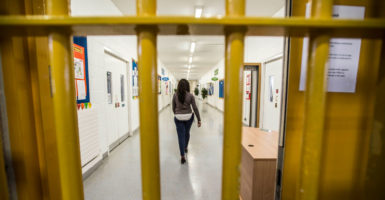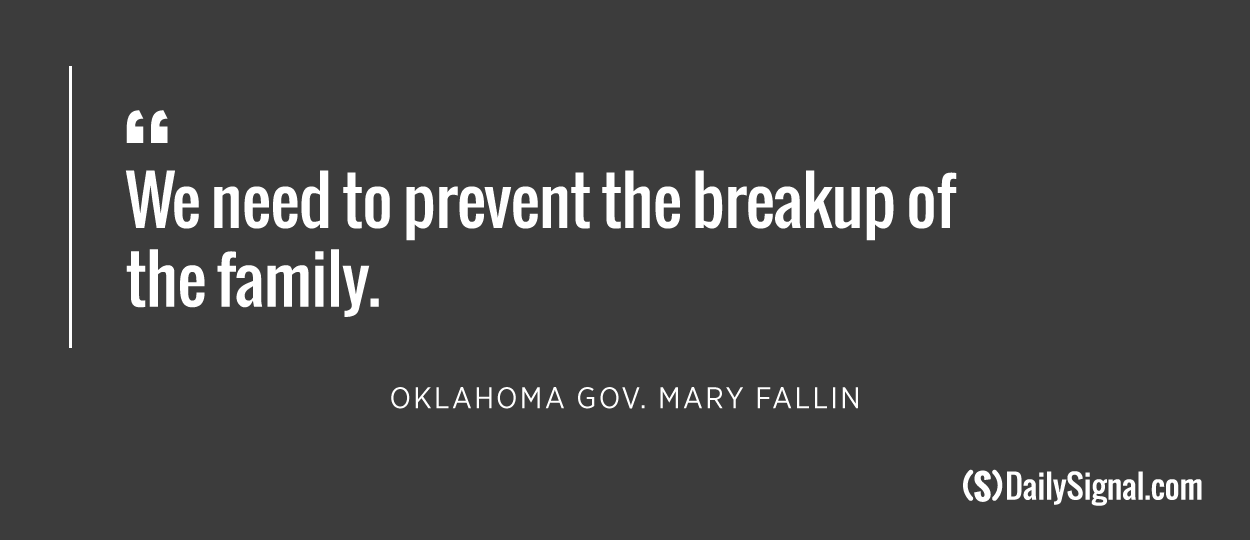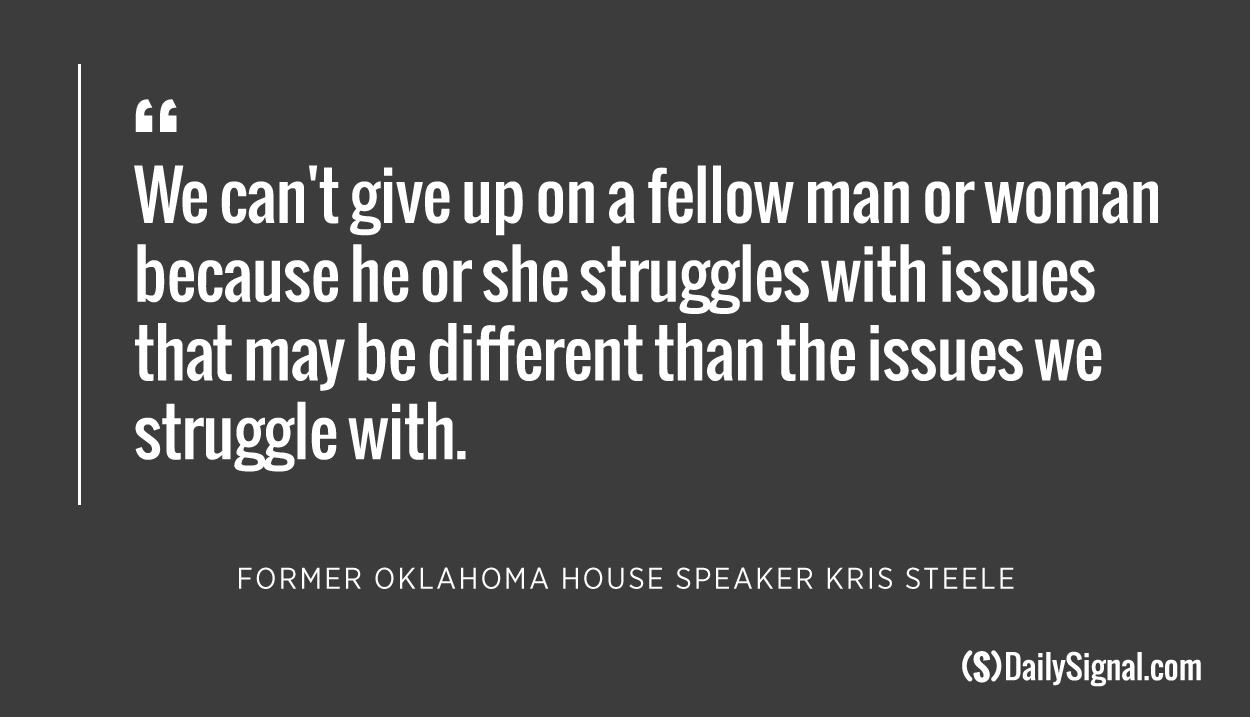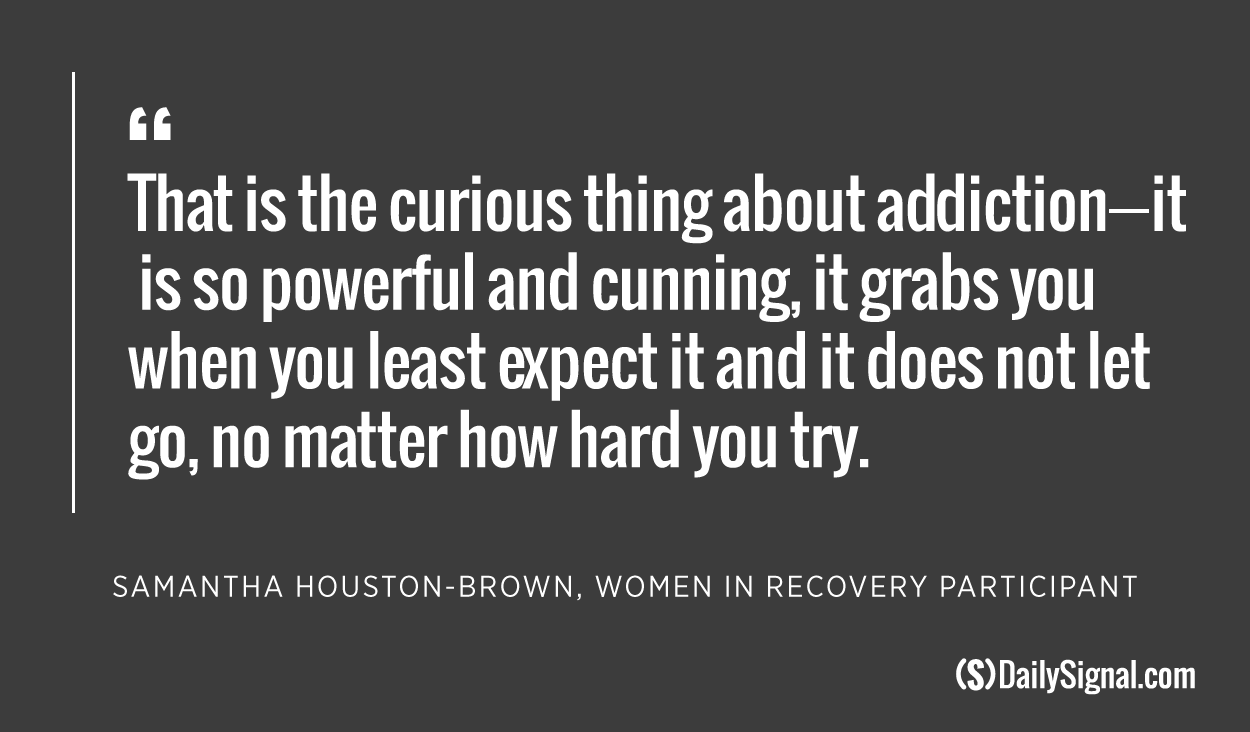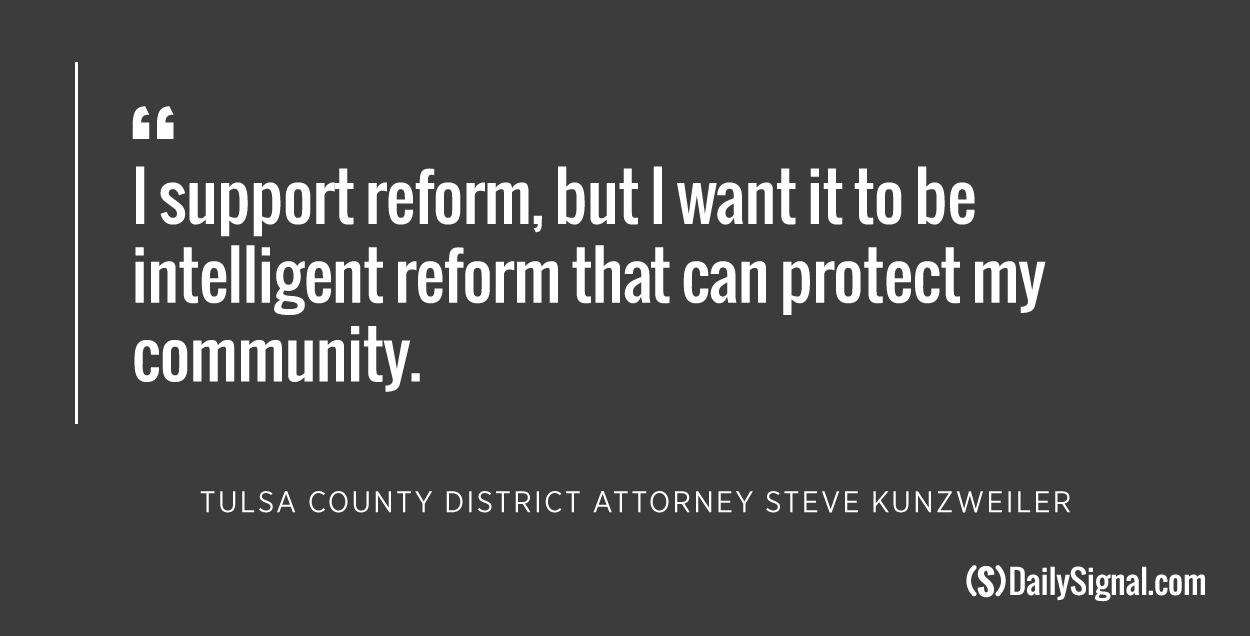During two previous prison terms, Samantha Houston-Brown had experienced milestones, including the time 11 years ago when she gave birth to her youngest child while handcuffed to a hospital bed.
After she was again charged for drug-related offenses last year, the latest missteps in a lifetime of gambling away her existence, Houston-Brown had finally run out of chances and was facing the near-certain prospect of meeting her life’s end behind bars.
“This lifestyle is very easy to fall back into, and every time I’ve gone back, it seems to hit me harder and faster than the last,” Houston-Brown, 43, tells The Daily Signal in one of a series of interviews.
“That is the curious thing about addiction—it is so powerful and cunning, it grabs you when you least expect it and it does not let go, no matter how hard you try.”
But then, Houston-Brown was thrown a lifeline afforded to few other repeat nonviolent offenders in her home state of Oklahoma, which has the highest incarceration rate for women in the U.S.
Houston-Brown’s defense attorney successfully persuaded a Tulsa County prosecutor, and judge, that her client’s underlying condition driving her criminal behavior—an addiction to methamphetamine—could not get better in prison.
Instead, her attorney argued, Houston-Brown would be best served if she could enter a few-of-its kind outpatient drug treatment program, Women in Recovery, a public-private service in Tulsa that specializes in helping people like her.
“I know from being incarcerated twice before that I was very scared, and I knew if I ever got out, I would fall right into the same path because I wouldn’t have the opportunity at all to learn something different,” says Houston-Brown, who is white and grew up middle-class.
The 100 to 150 females who participate in Women in Recovery every year are granted a delay in their sentence in return for successful completion of the program, requiring sobriety and participation in other forms of treatment and education, like workforce readiness training and lessons in how to be a better mother.
Nearly nine months since she entered Women in Recovery, Houston-Brown is sober, employed, and the beneficiary of regular visits with her oldest daughter, Breanna Delozier, 20, who can barely recognize the mother she’s never consistently had in her life.
“I am starting to know her,” Delozier tells The Daily Signal in a recent interview, a few days after she and Houston-Brown had attended a contemporary dance performance together. “It’s really cool seeing mom get excited about stuff like normal people do. Going through this program, I can see she is starting to love herself more. There is new hope. She has something to live for.”
‘Failed Systems’ for Women
Houston-Brown’s experience at Women in Recovery is what Oklahoma officials, including Gov. Mary Fallin, a Republican, want the state’s criminal justice system to look like.
Yet a treatment-first approach to drug crimes has not been possible in Oklahoma, due to the state’s strict sentencing laws enacted during the crack cocaine epidemic in the late 1980s and early 1990s.
Those policies contributed to overcrowding in Oklahoma’s prisons. The state’s prisons are filled to 112 percent of capacity—the second-highest rate in the country—with nearly 28,000 people behind bars. Half of those inmates are incarcerated for drug-related and other nonviolent crimes.
The state spends $578 million annually on corrections, up 18 percent since 2004, according to the Pew Charitable Trusts.
The prison problem is unique for women in Oklahoma.

Breanna Delozier and her mother, Samantha Houston-Brown, recently attended a contemporary dance performance together. “It’s really cool seeing mom get excited about stuff like normal people do,” Delozier says. (Photo: Courtesy of Samantha Houston-Brown)
Amy Santee is a senior program officer with the George Kaiser Family Foundation, a Tulsa nonprofit that helps administer Women in Recovery with the state’s Family and Children’s Services.
Santee says that Oklahoma incarcerates more women per capita than any other state, at a rate of 142 per 100,000. In any given year, that incarceration rate for women is double the U.S. average. About 65 percent of women in Oklahoma’s prisons were convicted of nonviolent drug offenses, Santee says.
The number of women in local jails across the U.S. is almost 14 times what it was in the 1970s, a growth in the rate of incarceration far greater than that of men, according to an August report by the Vera Institute of Justice.
In Oklahoma, the vast majority of women who encounter the criminal justice system are the children of divorced parents who were drug addicts. Many were abused as children, most are unemployed, and nearly 85 percent are mothers, Santee says.
She says before her foundation helped start Women in Recovery, the state had no existing prison diversion programs serving the “complex needs of women.” Women in Recovery receives no state funding, and is entirely paid for through donations and grants.
Today, a similar program called ReMerge exists in Oklahoma City.
“If you look at a woman’s pathway to prison, you see where there have been systems that failed them: parents, education, protected child services, a broken mental health and substance abuse system,” Santee tells The Daily Signal in an interview, adding:
Now they are locked into their addiction. Then, what happens is they connect with our criminal justice system. Once you do that in Oklahoma, it’s easy to get a felony [conviction], and once you have that it’s very easy to be sentenced to long, mandatory minimum sentences. And then it gets more complicated because a felony conviction ultimately acts as a scarlet letter that excludes a person from obtaining meaningful employment and reliable, stable housing even after they paid their debt to society.
The issue of women’s incarceration has especially troubled Fallin, a second-term governor who has made it a mission to approach criminal justice differently.
Since she became governor in 2011, Fallin says, the population of women in Oklahoma’s prisons has increased 21 percent.
“My mother was a social worker growing up, and I can still remember her having to leave in the middle of the night to pick up a child who’d been abused or abandoned by a parent oftentimes lost to prison,” Fallin tells The Daily Signal in an interview. “One of the ways we can change the generational curse of children experiencing the same problems as their parents is to help the parent to become a better parent, and prison doesn’t do that. We need to prevent the breakup of the family.”
A Drive for Change
Modeling policies after other Republican-led states that have adopted reforms, including Georgia, South Carolina, and Texas, Fallin has overseen dramatic changes to Oklahoma’s criminal justice laws.
In April, Fallin signed four bills passed by the Republican-controlled Legislature. The laws, set to go into effect in November:
- Reduce the mandatory minimum punishment for drug offenders charged only with possession, while reducing the maximum sentence, which had been life in prison.
- Raise the felony threshold for property crimes to $1,000 from $500.
- Provide for broader use of drug courts and community treatment.
- Give prosecutors discretion to pursue charges for certain lower level crimes as misdemeanors, rather than felonies.
Oklahoma still has more work to do. Last month, Fallin announced a task force she formed to develop “data-driven” reforms for Oklahoma’s justice system, with research assistance from the Pew Charitable Trusts and Crime and Justice Institute.
“There is also an old saying that if you continue to do things as you always thought, you will continue to get what you always got,” Fallin says, adding:
I am trying to change the way we have been doing things for decades and decades and decades, which have not worked to slow down drug abuse and offenses. What has worked is you get successful, proven programs backed by data, where you provide people treatment, work skills, and mental health care, and teach them how to get the family back together and be responsible citizens.

Oklahoma Gov. Mary Fallin says her personal experiences inform her belief that prison is not the best place to help a woman treat her addiction. (Photo: Pool/Reuters/Newscom)
In addition to efforts by Fallin and the Legislature, a coalition of community leaders calling themselves Oklahomans for Criminal Justice Reform was successful in obtaining more than 120,000 signatures from voters for two ballot initiatives in the November elections.
One of the ballot questions would reclassify certain low-level offenses, like drug possession and some property crimes, as misdemeanors instead of felonies. The other measure proposes to distribute the savings created by the first question, resulting from fewer people going to prison, to counties throughout Oklahoma. The money would fund supervision, drug treatment, and mental health services—programs such as Women in Recovery.
Kris Steele, the former Republican speaker of the state House who leads the coalition, tells The Daily Signal that these reforms, which would not be retroactive, could reduce the prison population 25 percent per year, saving $25 million to $30 million annually.
“I would tell you that, given how I know this Legislature thinks, the passage of these state questions would result in lawmakers feeling like the people have spoken and it’s appropriate—and even expected—to take a smarter approach on criminal justice policy going forward,” Steele says.
‘Not Conservative’
Steele’s introduction to Oklahoma’s troubled criminal justice system came in 2009, the year his colleagues chose him as House speaker.
A chief budget writer for the Republicans, Steele first saw the problems as a fiscal liability. He said he was appalled when he realized spending on the state’s Department of Corrections has increased about 172 percent in the past two decades.
“The definition of being conservative is doing a cost-benefit analysis and it’s important you achieve and obtain a positive return on investment,” Steele says:
The dollars we are giving to corrections are based on the premise of reducing crime and increasing public safety. But the reality is, our crime rate variable has remained unchanged and our violent crime rate has actually increased, and continues to. We are not getting a return on investment and to continue to throw more money on a broken system is not conservative, and not responsible.
Steele began to recognize the human element of criminal justice. And what started as an ugly, impersonal fiscal mess, Steele says, turned into “the most exciting issue I’ve ever worked on.”
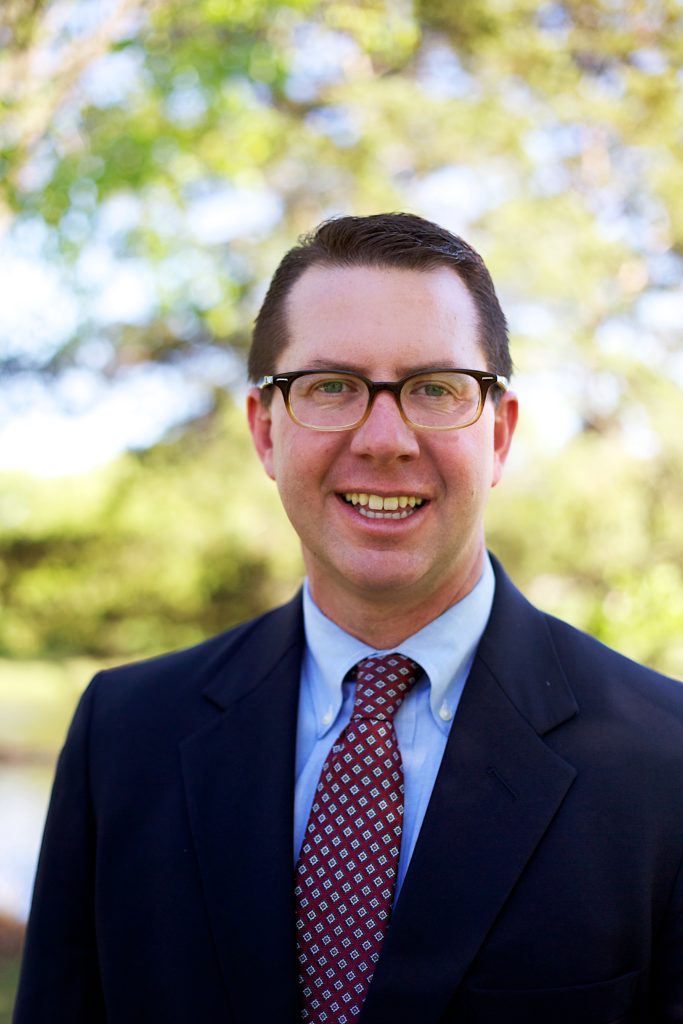
Former Oklahoma House Speaker Kris Steele says he is motivated to approach criminal justice with a treatment-first approach because “everybody is worth helping.” (Photo: Courtesy of Kris Steele)
In 2009, Women in Recovery opened, and Steele was one of its first visitors—and quickly a chief booster.
Steele, like other supporters of the program such as Fallin, learned to appreciate Women in Recovery’s approach—and success—viewing it as a vital outlet to stop the surge of drug users entering Oklahoma’s prisons, and to address the addictive tendencies that fuel repeat criminal activity.
“I come at this issue based on the premise that there is no such thing as a spare Oklahoman,” says Steele, who is also an ordained Baptist minister. “I mean that. Everybody is worth helping. And we can’t give up on a fellow man or woman, our neighbor, because he or she struggles with issues that may be different than the issues we struggle with.”
The Oklahomans who enter Women in Recovery are at their most desperate, as Houston-Brown was.
Those who qualify have charges or criminal records that make them ineligible for any other diversion program—or alternative to prison—such as drug court. Their charges must be drug-related felonies, and the alleged crime had to occur in Tulsa County.
Women charged with violent crimes cannot participate in the program.
Women in Recovery interviews potential participants shortly after they are arrested and arraigned, and enter a guilty plea.
Representatives from Women in Recovery work with the offender’s legal counsel, and the Tulsa District Attorney’s Office, to decide whether a woman is a fit for the program.
Together, the parties make a recommendation to the judge, who must approve a woman’s placement in the program. If she is approved, her sentencing is delayed as she completes her treatment in Women in Recovery, which usually lasts 14 to 18 months.
“We are the highest bar, and the most intensive, and if a woman who qualifies for our services don’t go here, then they go to prison,” says Mimi Tarrasch, executive senior director of Women in Recovery.
‘Multiple Addictions’
Before Houston-Brown entered Women in Recovery in January, she was looking at life in prison without the chance of parole if she decided to take her case to trial and was convicted on drug charges that included trafficking.
“What I was thinking was I needed to hit another good jackpot at the casino and leave the country—that was my first thought,” says Houston-Brown, who says she’s gotten out on bond in previous legal cases using winnings from habitual gambling at casinos.
While selling drugs is a more serious charge than using them, Houston-Brown’s lawyer and Women in Recovery advocates argued that her criminal mentality stemmed from her nearly 20-year addiction to meth. The Tulsa County District Court judge overseeing her case, Kelly Greenough, was convinced too, and granted Houston-Brown’s entrance into Women in Recovery.
About 36 percent of the women in the program have been to prison before, as Houston-Brown has.
“We were certainly not scared of Sam’s charges, and we don’t think she’s hopeless by any means,” Tarrasch says, referring to Houston-Brown. She adds:
We are fortunate that the judicial system allowed Sam to get into the program. If you understand a little about the brain, the disease of addiction around the brain, the treatment will address all of those issues. There are a lot of women who come in with multiple addictions, maybe money being one, gambling being one, and drugs always being one, and that really provides us with a broader opportunity to treat all of those addictions together.
Houston-Brown had tried other treatment outlets that failed to break her drug addiction. She says Women in Recovery is different because of its focus on treating more than the addiction itself.
Women in the program participate in more than 500 hours of treatment altogether, including individual and group therapy sessions where they are encouraged to think about, communicate, and accept the experiences in their past that contributed to their decision to use drugs.
Women in Recovery refers to these services as “trauma intervention sessions.”
“Until I came into this program I had no idea why I kept using and kept getting deeper and deeper into the lifestyle,” Houston-Brown says. “This is the only program that takes us back to our earliest memories. I realized all the choices I made centered around my feeling that I lack self-worth. From an early age, I was taught I was not good enough.”
An only child of parents who divorced when she was 2, Houston-Brown remembers growing up comfortably in Tulsa. But as early as the first grade, living with her working mother who had high expectations of her daughter, Houston-Brown says, she was left alone in the late afternoon and into the night.
“She was trying to do the best she could with what she had to work with, but she just didn’t have a lot of time for me,” Houston-Brown says of her mother. “That led me to look for love and acceptance outside of family—with men, with drugs, with people associated with drugs—because they accepted me.”
At 20 years old, Houston-Brown tried drugs, and by 26 she was addicted to meth.
Her condition worsened in 2001, when her husband at the time was sentenced to 10 years in prison for trafficking meth. That same week, Houston-Brown says, she was laid off from her teaching job at a private school.
By January 2002, Houston-Brown had caught her first criminal charge, for drug possession. Two years later, after more drug-related charges, she got her first prison sentence. She’s been connected to the criminal justice system most of her adult life, never able to stay clean long enough to change.
And she’s never been around long enough to be a mother to her four children, ranging in age from 11 to 20. She doesn’t have legal custody of any of them.
Learning From a Friend
Those who support alternatives to prison for drug offenders often argue that incarceration makes nonviolent people more criminal because they are surrounded by individuals who have done worse things than them.
In Women in Recovery, participants benefit from interacting with peers who share similar addictive histories. They can empathize with one another during group therapy sessions.
Lacie Maytubby, 35, knows a lot about what Houston-Brown has been through.
On Sept. 25, 2015, Maytubby came into Women in Recovery on a lesser charge—drug possession, not trafficking—and without ever experiencing prison, but her addiction to heroin and opioids was at its worst.
Maytubby had just learned her father was in the late stages of cancer. Her mother called and urged her to visit him at the hospital. Maytubby had not been there for her parents during most of her adult life, too blinded by addiction, but she certainly couldn’t miss the last moments of her father’s.
While she vowed to be present this time, the only way she could bear it, she says, was to numb the experience with drugs. So on the drive to the hospital, Maytubby says, she pulled over to the side of the road for a quick high.
By the time she was ready to face her father, and had arrived, he was already dead.
“My addiction just took the last precious moment I had with my father, and I felt like I didn’t even have a choice,” Maytubby tells The Daily Signal in one of a series of interviews. “It was what I had to do. That was the true moment I got scared. Wow, this is bigger than me.”

Lacie Maytubby says her effort to overcome addiction will be a “lifetime struggle.” (Photo: Courtesy of Lacie Maytubby)
Maytubby’s father previously had been a drug addict himself, but she learned this only after he died. Her parents had never told her, although Maytubby had always suspected something was different about her father, a car salesman by trade, who seemed to empathize more with her struggles.
Yet her parents were private and sheltering, having homeschooled her in an environment where religion was practiced—her mother was a Jehovah’s Witness minister—and formal education was not.
As a curious 15-year-old, Maytubby snuck away to a Tulsa skating rink to try cocaine with some boys.
“I was so sheltered that I was willing to do anything to give me a sense of freedom,” Maytubby says. “It just so happened drugs were what was presented to me. That’s the first thing I was choosing to do on my own. Whether it was the right decision or not, it was my decision.”
When Maytubby’s parents discovered she was using drugs, they kicked her out of the house at 16.
She never attended college, and was first arrested in 2001 when she totaled her car after passing out while driving high.
As the police applied handcuffs to haul Maytubby away, her then 2-year-old eldest daughter, Emma, cried in her car seat.
Fifteen years later, Maytubby is sharing all of this in group therapy with Houston-Brown at Women in Recovery, trying to connect the past to her present, finally prepared to say she was ready to change.
‘Break That Cycle’
Houston-Brown and Maytubby, who undergo regular drug tests, have been sober throughout their time in the program.
Once a month, they testify before the judge assigned to their case about the progress they’re making.
If they fail to stay sober, they can be thrown out of the program, and likely sent to prison.
Tarrasch, the director, says 70 percent of Women in Recovery’s participants complete the program successfully.
Those who finish to the satisfaction of the judge can have their sentences outright dismissed or deferred, meaning a sentence is postponed and ultimately can be thrown out along with the conviction. A sentence also may be suspended, meaning the offender is convicted and will complete the conditions of her sentence outside prison.
Even after the judge makes a decision, recovery from addiction is nowhere near complete, and its legacy carries on, especially for women—and mothers.
According to Tarrasch, children in Oklahoma with at least one incarcerated parent are five times more likely to go to prison at some point in their life.
Approximately 26,000 Oklahoma children have a parent in prison, reports the George Kaiser Family Foundation.
To protect the next generation from paying for their parents’ problems, Women in Recovery provides services to offenders’ children and incorporates them in the healing process.
Women in Recovery works with caregivers of the children to help enroll them in education and to connect them with after-school activities.
The program’s employees also ask caregivers to allow the children to visit the center. Children can participate in counseling there offered specifically to them, without the presence of their mothers.
“One thing unique with our program is it is multigenerational,” says Tarrasch, who adds that about 85 percent of Women in Recovery participants have children. “We don’t want Sam or Lacie’s kids to get into the juvenile justice system. We know that children have also experienced trauma as result of their mom’s addiction and we want to break that cycle.”
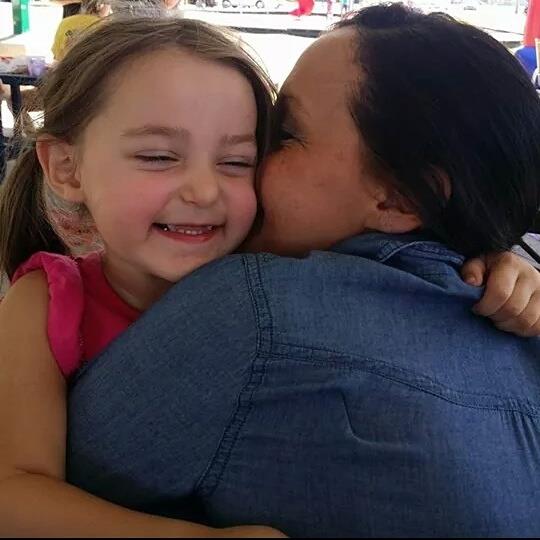
Sober for more than a year, Lacie Maytubby is now able to regularly spend time with the youngest of her two daughters, McKenzie. (Photo: Courtesy of Lacie Maytubby)
At her offsite apartment that she shares with roommates—Women in Recovery pays the rent with the help of community partners—Maytubby has overnight visitation rights with the youngest of her two children, McKenzie, 4, whose father has custody.
Last month, Maytubby took McKenzie to her first day of preschool. Maytubby broke down and cried, for a reason her daughter couldn’t quite comprehend.
Maytubby can’t recall if she escorted her older daughter, Emma, 13, to her first days of school.
Maytubby lost custody of Emma when she was 7. She wasn’t quite committed to being a mother even when she had custody of her daughter. Emma now lives in Missouri with her paternal grandparents, and talks daily with her mother by phone.
“With my oldest daughter, I was always in a rush and never took the time to enjoy where she was in the present moment,” Maytubby says of Emma, adding:
Now I can do that. That’s been huge in both our lives. She is back at this place where she’s comfortable talking about the future instead of dwelling about whether I’m going to be in jail.
The biggest thing this program has taught me is that mistakes are going to happen, and there will be things in life we may not pick and choose, but letting my children know from my actions that it’s all about our response after that.
Meanwhile, Houston-Brown’s oldest daughter, Breanna Delozier, now 20, is a frequent visitor to Women in Recovery, where she participates in therapy with other family members of offenders.
Mother and daughter also see each other on the weekends, when Delozier takes her out to do laundry.
It’s a far cry from all the times Delozier visited Houston-Brown in prison, where she had to endure pat-downs and metal detectors, all so she could support a mother who she knew she had a lot in common with—they share an affinity for tell-it-like-it-is bluntness—but who was never there for her.
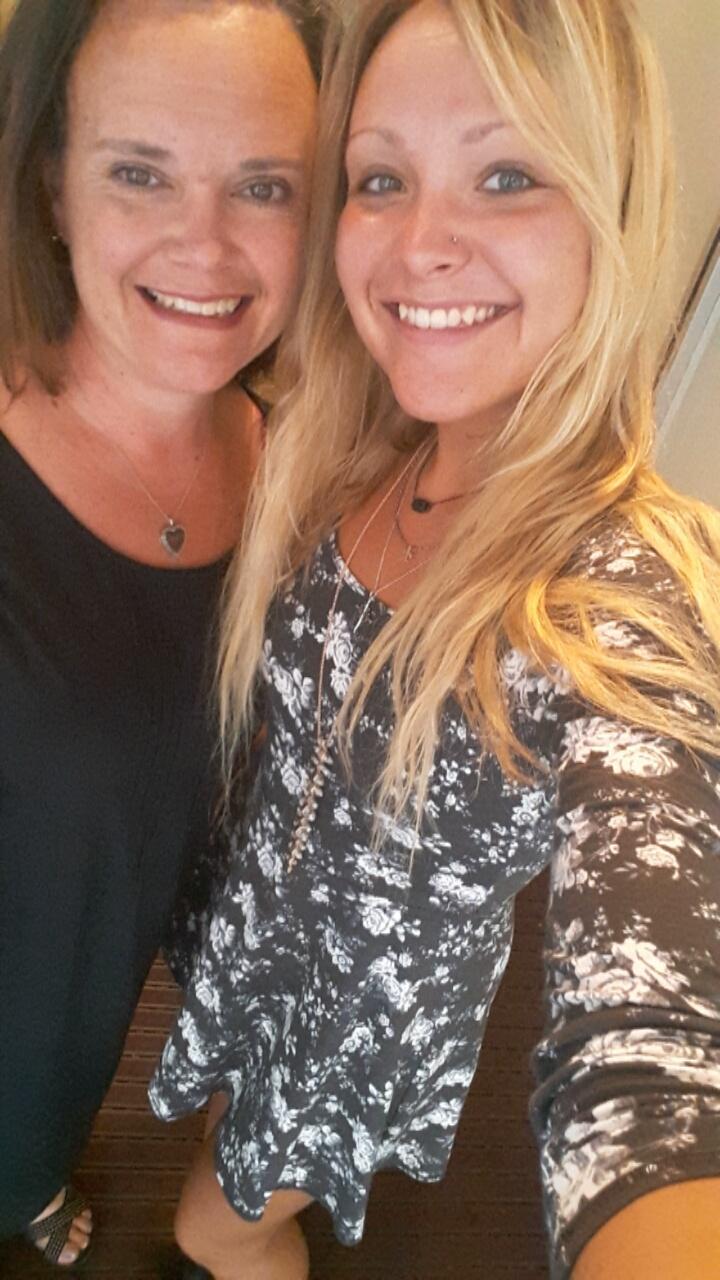
Samantha Houston-Brown and her oldest daughter, Breanna Delozier, are finally getting to know each other. (Photo: Courtesy of Samantha Houston-Brown)
Delozier’s father, who is separated from Houston-Brown, has also spent his life in and out of prison. One of Delozier’s earliest memories was her seventh birthday, when both of her parents were arrested and booked in jail at the same time.
“Looking back at it now, I have a lot of built-up sadness and anger that I grew up without a mom,” says Delozier, who was raised by both sets of grandparents and is studying to become a paralegal. “I don’t understand why I am less important, why your significant other, or drug use, or whatever that gets you off, always comes before me. But I am practicing this new thing with forgiveness. I understand now it’s not just that she didn’t love me. It’s that she didn’t love herself enough.”
Houston-Brown is also in frequent contact with her second-oldest child, 16-year-old Adam, a high school student living with his father and grandmother. Adam and Delozier do not have the same father.
Houston-Brown’s two youngest children, daughters who are 11 and 13, share the same father and have been legally adopted by Houston-Brown’s parents. Houston-Brown doesn’t have a relationship with either daughter because she is not on speaking terms with her mother.
“My children have been through a lot,” Houston-Brown says. “Looking at how the cycle goes as far as addiction, my children have a higher chance at that since I was in prison twice, and their fathers have all been in prison.”
She adds:
I try to see the positive that if I keep going the way I am going, by the time my two youngest are 18, I will have had a good five, six, or seven years of recovery under my belt and maybe that will give my parents more confidence in me. But maybe not. I don’t have a very good track record, so I don’t blame them for not trusting me.
‘Intelligent Reform’
While Maytubby and Houston-Brown are close to graduating Women in Recovery and learning their sentencing fates, no one can say for sure how recovered they will be—and whether they’ll come back into the criminal justice system again.
If precedent means anything, their chances are good.
Women in Recovery boasts a 5 percent recidivism rate for offenders who finish the program, says Tarrasch. That’s compared to the 14 percent re-offense rate for those who interact with the state Department of Corrections without Women in Recovery.
Earlier this year, Women in Recovery won the Excellence in Addictions Treatment Innovation award from the National Council for Behavioral Health, beating out more than 1,000 entrants.
Prison admissions are rapidly declining in Tulsa County, the Kaiser Family Foundation’s Santee says.
Steele, the former speaker of the state House, says he hopes Women in Recovery’s successes show citizens the value in taking a different approach to drug addiction.
If Oklahoma voters approve his coalition’s two ballot measures in November, he says, it would encourage other jurisdictions in the state, using money they reap from prison savings, to invest in similar programs.
“Women in Recovery demonstrates the value in these reforms,” Steele says. “They have established a very effective treatment-based model to address issues of addiction and trauma and mental illness in the lives of women. They have demonstrated a fiscally responsible approach to helping women in Oklahoma reach their full potential in life.”
Others are not so sure that Women in Recovery’s successful outcomes justify the degree of reform that Steele and others are seeking.
Steve Kunzweiler, the Tulsa County district attorney, supports the measures that the Legislature passed, and Gov. Fallin signed, earlier this year.
Kunzweiler tells The Daily Signal that he’s been “begging for reforms” to the criminal justice system, to help him and his prosecutors deal with the “perfect storm of highly addictive drugs, and laws that have lagged in response to that problem.”
And Kunzweiler is a big fan of Women in Recovery.
“I love that program,” he says in an interview. “It’s a perfect example of how the private sector can step forward to help.”
But he says he worries about the state going too far and too fast, and he advocates waiting to see how the legislative reforms play out before deciding to act again.
“I am Catholic,” Kunzweiler says. “And being Catholic allows me to be very conservative and liberal at the same time. I support reform, but I want it to be intelligent reform that can protect my community. I don’t want to send people who are addicts to prison. My office frequently fights very hard to keep people away from prison.”
He adds:
Yet you can bring a horse to water, but you can’t make them drink. I can take them to treatment, but if they continue to use drugs, sometimes they need to go to prison to open their eyes and wake them up.
‘Who She Is Being Now’
Houston-Brown and Maytubby are trying to prepare themselves not only to avoid prison, but to pursue productive, regular lives.
With the help of employment specialists at Women in Recovery, Houston-Brown is helping out at a law firm and wants to pursue a career in business management.
Maytubby recently was promoted to a training position at a pizza restaurant. She hopes to go to college so that she can work in an outreach program focused on helping people like her.
Delozier, Houston-Brown’s oldest daughter, has come to understand that hope means only so much.
During spare time, when she’s not focused on advancing her own life and looking after her mother’s, Delozier watches cartoons, trying to reimagine a normal childhood she never had.
“It sounds very bad to say history always repeats itself, but my mom has been in and out of prison and jail ever since I can remember, and in and out of different programs to get better,” Delozier says, adding:
So part of me, the history-always-repeats-itself part of me, wants to say she will turn back around and use [drugs]. But I heard stories from our family of how beautiful of a person my mom was. And the stories that they used to tell me are starting to match up more and more with who she is being now.
























